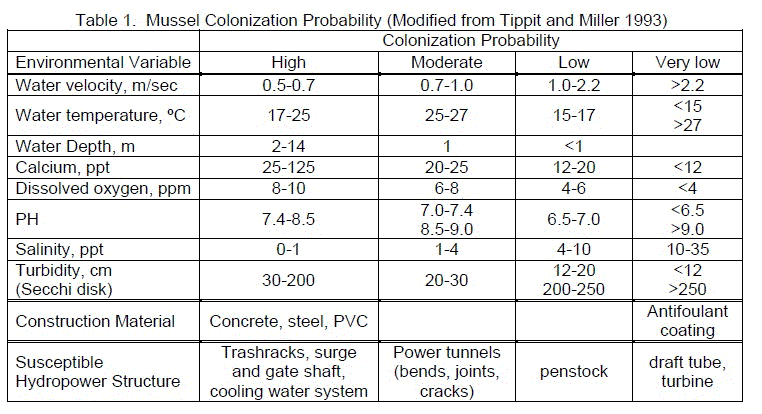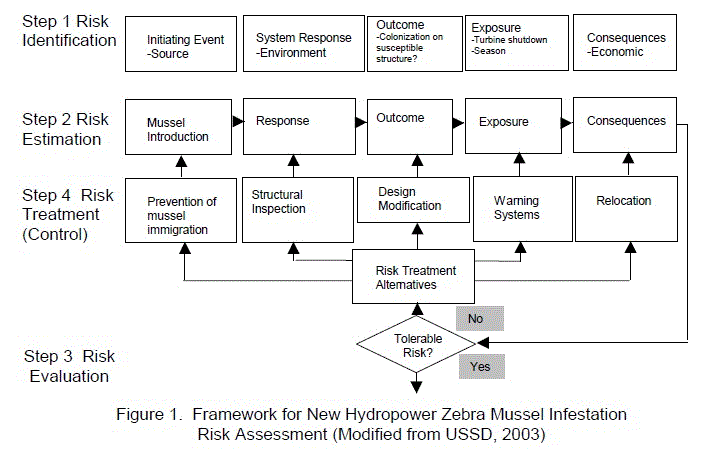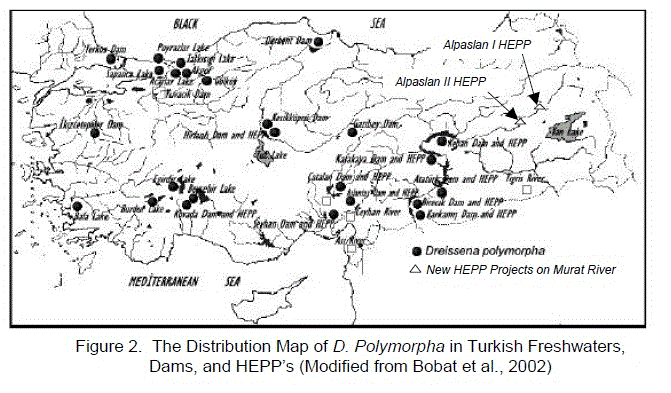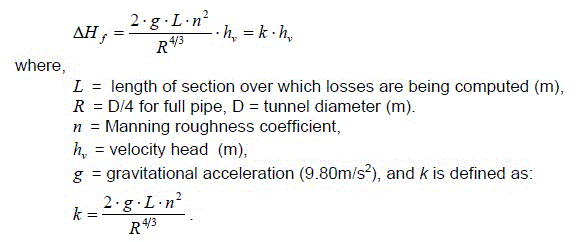Abstract
Zebra mussel, Dreissena polymorpha, is a biofouling organism that lives generally in freshwater ecosystems. Zebra mussel
infestation has occurred at various freshwater structures and systems including raw water intakes, industrial and domestic distribution pipelines,
and hydropower facilities at its native regions as well as distant locations. A study was conducted to perform risk assessment and to develop preventive
measures for zebra mussel infestation at a planned hydroelectric power plant (Alpaslan II HEPP) in
southeast Turkey. Zebra mussel is native to Anatolia region and existing hydropower facilities have significantly been affected by mussel infestation. The
risk assessment was conducted by considering effects of various factors on zebra mussel infestation. The factors included environmental conditions, factors
related to materials used in construction of various components of a HEPP as well as the susceptibility of various components to infestation due to routine
operation of a facility. Quantitative study of head loss due to major infestation for Alpaslan II HEPP indicates approximately 4% reduction in power generation.
A two-step process is proposed to prevent mussel infestation at hydroelectric power plants. The method makes use of the water hammer effect that occurs during
rapid shutdown of the turbine combined with an automated system for providing chemicals to the power plant water to remove and kill zebra mussels associated with
various components of a facility. The proposed system constitutes a proactive-reactive chemical treatment system.
INTRODUCTION
Zebra mussels are bivalve mollusks related to oysters, clams, and freshwater mussels. They can grow up to 5 cm in length and they have elongated and pointed thin
shells with zebra-like pattern with stripes. During its most mobile stage, planktonic veliger, zebra mussel larvae can attach to an object with more than 100 proteinaceous byssal
treads that are secreted from a gland at the base of its muscular foot. These treads are extremely tenacious; an attempt to remove by hand usually results in breaking of the shell or
damaging of the soft tissue of the mussel. Large numbers of byssal attachments to hard surfaces in raw water systems is the main reason why this species causes problems in industrial and
domestic water supplies.
Zebra mussel achieves high densities immediately after colonizing a new habitat. Zebra mussel densities on an intake screen around Great Lakes area climbed from 200
individuals/m2 to 700,000 individuals/m2 in one year (Miller and Payne, 1992). Geometric increases in population on the order from 1 to 105 in 2 years have been reported in the
Mississippi Valley (Yager, 1994).
The ballast water of ships could transport exotic species such as the zebra mussel. O’Neill and Dextrase (1993) describe the spread of mussels in North America in detail.
The zebra mussel has spread throughout the Great Lakes, St. Lawrence Seaway, Mississippi River, other locations throughout Eastern North America, (USGS, 2004). In the U.S.,
industry has spent over 120 million dollars on zebra mussel control, which is much less than the estimated 5 billion dollars of damage for 1990 and electrical power generation
industry was the major spender (O’Neill, 1997). Spread of mussels and its effects on locks and dams are discussed Yager (1994). Introduction of a similar species, black-striped
mussel (Mytilopsis sallei) to Central America and Indo-Pacific is believed to have happened through the Panama Canal with attachment to the hull of ships. A recent investigation indicates that
Panama Canal tunnels
1 HydroVision 2004 - Copyright HCI Publications, 2004 - www.hcipub.com
have about 3- to 5-cm-thick mussel and oyster cover. In addition, zebra mussels have significantly spread to India, Singapore, Hong Kong and other Asian ports. Strict quarantine and
protection have prevented mussel infestation in Australian freshwaters thus far.
Zebra mussel infestation threatens freshwater infrastructures including raw water intakes, and industrial and domestic distribution pipelines. Zebra mussel is also a problem for the hydropower
industry. A number of components of a hydropower facility is susceptible to zebra mussel infestation. These components include trash racks, penstocks, turbine headcovers, embedded piping,
raw water-cooling systems, instrumentation, gates, and fish ladders. Many countries have adopted strict legislation and engineering control measures to prevent the spread of zebra mussels.
However, considering the infestation of major waterways and the possible use as a biological weapon, unpopulated waterways remain susceptible to zebra mussel infestation. New hydropower
projects need to be designed with zebra mussel control/prevention measures.
In 1981 Turkey launched her largest irrigation and power generation project, Southeast Anatolian Project (GAP), for the development of her Southeast region. Within 75,358 km2, 22 dams, 19
hydroelectric power plants (HEPP), and 2 irrigation tunnels have been constructed on the Euphrates and the Tigris Rivers and their tributaries. There are five large dams on Euphrates River
within the Turkish border. Four dams have been built within GAP’s scope.
Alpaslan I (recently completed) and Alpaslan II (under design) dams (both out of GAP’s scope) are on Murat River, a tributary to the Euphrates River. Alpaslan dams are multi purpose dams:
irrigation, power generation, and regulation for GAP dams for firm power generation.
Zebra mussel problem was first observed in 1964 in Kovada I HEPP, which later spread to Kovada II HEPP in Southwestern Turkey. As of 2001 three GAP downstream dams, Ataturk, Bilecik, and
Karakamis are infested with zebra mussel (Hengimen et al., 2002). In 2003 zebra mussel was detected in two of the GAP upstream dams: Keban and Karakaya (Bobat et al., 2003). After the
completion of Alpaslan I HEPP, Alpaslan II HEPP can be affected by mussel colonization due to the increase in water temperature at the downstream reservoirs.
An overall framework for dam safety risk assessment was provided by USSD in 2003. This study provides a risk assessment framework for zebra mussel infestation and possible prevention and
control measures for Alpaslan II HEPP, which is currently under design by Alpaslan II Construction Consortium. In addition, an automated proactive preventive method is described in the paper.
The risk assessment methodology and the suggested prevention and control measures can be applied to other new HEPPs faced with the zebra mussel problem.
Treatment, Control, and Prevention of Zebra Mussel Infestation
Numerous methods have been identified for control/prevention of zebra mussel infestation and the resulting problems. The methods can be classified as chemical, biological, or physical. Management strategies that use these methods may be reactive, proactive, or preventive in nature. Mechanical cleaning (physical removal of mussel with water jet or scraper) is usually combined with one or two of these following methods:
Thermal Shock: Dewatering of tunnels during cold weather periods is found to be an effective method of killing mussels (Payne 1992a and 1992b).
Reducing pH Level: Reducing pH level by adding sulfuric acid or exposure to sulfuric acid will destroy the mussels.
Antifoulant Coating: Silicon based coatings provide a nontoxic antifoulant layer and can reduce mussel accumulation (Wells et al., 1997).
Chemical Treatment: Chlorine can be used to kill planktonic veliger zebra mussel larvae or can prevent them from settling in raw water piping systems. Veligers are much more sensitive to chlorine than adults and concentrations as low as 0.5 mg/liter can be sufficient to prevent larval settlements (Payne and Lowther, 1992). Chlorine treatment is used commonly in U.S. as the method to protect power plant raw water systems from mussel infestation (Harrington et al., 1993). However, the cumulative effect of chlorine use for mussel control in large rivers can be significantly detrimental to the environment. EPA and other agencies have expressed concern over increased use of biocides. Chlorine discharge into natural waters will be restricted in the near future. Because of uncertainties associated with most biocides, only chlorite (on a continuous basis), and chlorite and bromine (on an intermittent basis) are authorized for use in major stream flows in the U.S. (Howe et al., 1994).
Other Methods: Use of natural predators such as certain species of fish and diving ducks; use of ultraviolet light; use of electrolytic devices; dissolved oxygen reduction and anoxia (Chang et al., 1997); use of radio waves at certain frequencies; drying; use of biodegradable, natural biocides such as endod plants (Lee et al., 1993) have been suggested for controlling the mussel populations.

colonization. The probability is inversely proportional to the velocity. Effects of velocity on the feeding of mussels are discussed in detail in Ackerman, 1999.
Calcium is also an important determinant of mussel colonization. Calcium in water is the source of shell material for zebra mussels. It has been shown that water calcium content is strongly correlated to mussel density (Mackie et al., 1989).
Zebra mussels first colonize along discontinuities such as construction joints, monolith joints, or cracks in monoliths. Although future research may identify effective antifouling compounds that can be incorporated into concrete, none is currently available for zebra mussel control (Wong and Miller, 1992). Care should be given to selecting compounds for control of zebra mussel infestation. These compounds should remain innocuous to hydropower structures.
A new framework for zebra mussel risk assessment for new hydropower projects is proposed in Figure 1. As presented in the column structure of the figure, the assessment process follows a five-step sequence: initiation events, system responses, outcomes, exposure, and consequences. Both natural and intentional initiating events are considered. Various consequences can be considered, including loss of hydropower, shutdown for treatment, and potential damage to hydropower structures

Similar to the recommended risk assessment framework by USSD (2003), there are four major components in zebra mussel risk assessment as illustrated in the row structure of Figure 1. These are: 1) risk identification, 2) risk estimation, 3) risk evaluation, and 4) risk treatment. In Figure 1, the term “risk treatment” refers to the consideration of treatment alternatives (security, control, and reduction) using risk analysis and risk assessment.
The framework outlined in Figure 1 is applied to the analysis of a hydropower project, Alpaslan II HEPP, currently under design.
Risk Assessment for Zebra Mussel Infestation at Alpaslan II HEPP
Various HEPPs and reservoirs are infested by zebra mussel in Turkey (Figure 2). Alpaslan II HEPP is susceptible to infestation due to connection to waterways infested with the mussel. Various factors that are expected to control the colonization of zebra mussels in Alpaslan II HEPP are described below. In addition, various potential exposure pathways and possible treatment alternatives are explained.

Environmental Factors:
Temperature:
Threshold temperatures for larval development and reproduction of zebra mussel on the Euphrates River were determined to be 8.5?C and 11.5?C, respectively (Hengirmen et al., 2002). Anticipated reservoir water temperature is 4?C to 15?C for the Alpaslan II reservoir, with temperatures during the summer months rising within the optimal range for larval development and reproduction.
Calcium:
Porewater analyses from soil samples indicate that sufficient calcium is available to support zebra mussel colonization.
Dissolved Oxygen
Currently, no information is available on the dissolved oxygen level; however, favorable conditions for mussel infestation are expected.
pH:
The pH of Alpaslan II reservoir water is expected to be around 7, indicating moderate to high probability of mussel colonization.
Salinity:
Low salinity of Alpaslan II reservoir is expected.
Turbidity:
Low turbidity is expected in Alpaslan II reservoir due to the upstream presence of Alpaslan I HEPP.
Exposure:
Construction Materials:
Alpaslan II HEPP structures will be constructed from available, economic construction materials and will be susceptible to mussel infestation.
Hydropower Structures Susceptible to Mussel Infestation, Possible Energy Losses at
Alpaslan II HEPP, and Available Treatments
Susceptible Structures
Trash Rack:
Trash rack is a simple structure that eliminates large debris from entering and/or clogging the penstock. Since it is a low velocity intake, it is one of the structures most susceptible to mussel colonization. Any activity that decreases the net effective open area of the trash rack will introduce an additional head loss to the hydropower system (Jones et al., 1997).
There are many cases of mussel colonization at trash racks (Hengirmen et al., 2002). A single layer would have little effect on head loss; however, a major colonization can reduce the net area significantly, with proportionate velocity increase. Table 2 provides example calculations of added head loss associated with (1) minimal reduction in open area (clean); (2) single layer mussel growth; (3) double layer mussel growth; and (4) major colonization with reduction in cross sectional area by a factor of 3.
The calculated head losses for major colonization are unacceptable and control mechanisms are required. The most effective treatment methods are antifoulant coating, cyclic drying, or thermal shock with mechanical cleaning. The last two methods require the minimum pool level to be below the trash rack. For Alpaslan II HEPP minimum pool level is above the trash racks, therefore, antifoulant coating is the best preventative alternative.
6
Power Tunnels and Penstock:
Friction losses are an important consideration for hydropower projects with long tunnels. At the Alpaslan II project, friction losses account for approximately 40% of the total head loss. Friction loss, AHf, can be calculated with the following equation:

Roughness coefficient and open area can change due to mussel colonization. These changes impact the fluid velocity as well as the friction losses.
Calculations were made to determine the impact of mussel colonization in the tunnels of the Alpaslan II HEPP Project. For the base case, corresponding to negligible colonization, the roughness coefficient is approximated as 0.013 and 0.012 for the concrete and steel tunnels, respectively.
Modifications of the roughness coefficient, n, were assumed for the three colonization possibilities already investigated in Table 2. For a single layer and double layer, the revised n values are 0.018 and 0.022, respectively both for concrete and steel tunnels. If a major colonization is present within the tunnel, a reduction of tunnel area can be assumed with n = 0.022, D = 6.7 m.
The head losses calculated for the base case, as well as the three levels of colonization are provided in Table 3.
Analysis provided in Table 3 suggests that mussel colonization in the tunnel can significantly increase head losses. Such losses result in a decrease in power output by the turbines, and have a direct impact on the economic viability of the project.
Practical considerations limit the probability of mussel colonization in the tunnels. Water movement through the tunnels decreases the ability of mussel attachment and feeding. The penstock is most susceptible to planktonic veliger attachment and mussel colonization at discontinuities, especially when the turbine stops and stagnant water remains in the penstock. Drying and mechanical cleaning and thermal shock with mechanical cleaning are the most effective treatment methods for the penstock. The intake gate should be closed and the penstock and surge tank should be drained prior to application of any of the proposed methods. Antifoulant coating may not be suitable due to possible erosion in the tunnels.
Surge and Gate Shaft:
The surge shaft has no direct involvement with power generation; however it is an essential component of the penstock. Conditions within the surge shaft are particularly favorable for mussel colonization. Water is stationary (with possibly a slight current due to high velocity flow in the tunnels) in the surge shaft. Colonization at connecting pipes and the possible resultant clogging can have adverse effects on the function of the surge tank. Antifoulant coating, chemicals, drying, and thermal shock with mechanical cleaning are the most effective methods of treatment in the surge shaft. Prior to the application of drying, thermal shock, or mechanical cleaning, the intake gate should be closed, and the penstock and surge tank should be drained.
Water Cooling System and Fire Fighting Systems:
It is necessary to control the heat generation in the turbine for efficient power generation. It is most economical to use raw water heat exchangers in a water-cooling system. The velocity within the primary condenser can exceed 2 m/sec. However, cooling filters and speed governors and other piping systems have been known to be clogged by zebra mussel infestation because of living or dead mussel shells (Hengirmen et al., 2002). Fire fighting systems are also susceptible to clogging.
Backwash filtration system (Robinson and Kuhlo, 1998) or well water rather than raw river water can be used safely for cooling water pumped into the powerhouse. Sulfuric acid, chlorination, and corrosion inhibitors are the chemical methods available for reducing the probability of mussel infestation in these cooling water systems.
Possible Total Reduction in Hydropower A simple hydropower equation is provided below: P = 8 * Q * H * e, where P is the power generated in kW, Q is the discharge in m3/s, H is the net head in m, and e is the efficiency of the turbine (generally 95%). Net head is the total head difference between the reservoir headwater and the turbine tail water elevation minus the losses between these two points. At the Alpaslan II project, the average operation levels for head and tail water are 1348 m and 1268 m, respectively. The various head losses that are expected to incur at the Alpaslan II HEPP Project in the absence of mussel infestation are provided in Table 4. Head loss at the clean trash rack is insignificant in comparison to the other loss terms. (Alpaslan II HEPP Consortium, 2004).
Proposed Proactive-Reactive Method
Although reactive, proactive, and preventive measures have been used extensively for mussel control, none of these methods have been developed for the application to hydropower structures. Hydropower structures include both static and dynamic systems. This duality can be utilized for a self-cleaning system when the penstock is most susceptible to mussel bonding. Proposed method includes the following two steps:
1.
Use of water hammer effect during rapid turbine shutdown.
2.
Injection of treatment chemical with water hammer, dispersion of chemical and the resulting effects.
1. Water Hammer Effect:
Hydropower systems are not purely static or purely dynamic. Some components experience static and dynamic loading at the same time, or from time to time, during the operation of the turbine. Penstock is one of the components that experiences both static and dynamic hydraulic pressures during operation. The significant dynamic pressure is the water hammer effect during the rapid turbine shutdown and its counterpart during the rapid turbine start. Water hammer is caused by the sudden transformation of kinetic energy to pressure energy and vice versa. The large pressure surges associated with water hammer can be minimized by the inclusion of a surge tank, which dissipates the peak pressures associated with the water hammer. Total pressure in the penstock with the addition of water hammer is approximately 1.5 times the static pressure. Mussel population is susceptible to sustained pressure changes. However, resultant pressure during water hammer and/or the duration of the pressure during the water hammer are not expected to be sufficient for the eradication of mussel population. Therefore, a second step is required for the treatment of mussel infestation as described below.
2. Injection Treatment:
Rise of the water in the surge tank during turbine shutdown is proposed to be used for chemical treatment. Proactive/reactive chemical treatment will be initiated upon shutdown of the turbine as the water level in the surge tank starts rising. This will prevent settling of any adult mussel or veliger attachment on to the penstock or the surge shaft, and kill any existing colonies.
One or more configurations are possible for an automated release of chemicals. In one possible setup, chemicals will be available within a fixed open chamber attached to the surge tank. A rising water level in the surge tank floods the chemical chambers. This initiates mixing and release of chemicals at the surge tank surface. Mixing will be accomplished with water hammer currents in the surge tank; dispersion; and gravity if the density of solution is different from that of water.
A second alternative makes use of the rising water level to provide a buoyant lift to tanks which will exert a pressure on the chemical solution tank, that will result in opening of a gate. Chemicals will be released through this gate. Alternatively, the tank can be flexible so that rising water can exert pressure to it. The tank is connected to lower elevation with a hose, which is terminated with a one-way valve and a perforated section. The one-way valve prevents water from entering into the hose when the pressure is high, but releases chemical when the pressure is low. The perforated section will provide a larger area for chemical injection. In both designs, the chemical tank should be sufficiently close to the surface in order to have easy access for refilling.
In either setup, solution released into the surge tank and penstock moves into the stationary water column and kills planktonic veliger zebra mussel larvae. Depending on injection location, time, and concentration, the chemical can reach and be effective at the trash racks as well. Advective propagation and diffusion of the chemicals in the surge tank and the penstock will be the predominant mixing mechanisms subsequent to mechanical mixing by water hammer.
CONCLUSION
A study was conducted to perform risk assessment and to develop preventive measures for zebra mussel infestation at a planned hydroelectric power plant
(Alpaslan II HEPP) in southeast Turkey. The risk assessment was conducted by considering effects of various factors on zebra mussel infestation. The factors included
environmental conditions, factors related to materials used in construction of various components of a HEPP as well as the susceptibility of various components to infestation
due to routine operation of a facility. Quantitative study of head loss due to major infestation for Alpaslan II HEPP indicates approximately 4% reduction in power generation.
In addition, critical damage to the penstock and turbine is possible if surge tank tunnels or water cooling systems are clogged.
A two-step process is proposed to prevent zebra mussel infestation at hydroelectric power plants. The method makes use of the water hammer effect that occurs during rapid
shutdown of the turbine combined with an automated system for providing chemicals to the power plant water to remove and kill zebra mussels associated with various components of
a facility. The proposed system constitutes a proactive-reactive chemical treatment system. While the method is originally developed for the Alpaslan II HEPP, it can be adapted
to other HEPPs as well. It is recommended that risk assessment be conducted for zebra mussel infestation for new hydro power plants as well as existing structures. In addition,
preventive measures should be included against zebra mussel
infestation in the design and operation of these major facilities based on the local conditions at a site.
References
1.Ackerman, J.D., 1999, “Effect of Velocity on the Filter Feeding of Dreissenid Mussels (Dreissena polymorha and Dreissena bugensis): Implications for Tropic Dynamics”, Canadian Journal of Fish and Aquatic Sciences, No. 56, pp.1551-1561.
2. Alpaslan II HEPP Consortium, 2004, Hydraulics Report, Chicago, IL.
3. Bobat, A., Hengirmen, M.O., Zapletal, W., Altinayar, G., Ustundag, S., Cevlik, H., 2003, “The Preliminary Observations on Distribution of the Zebra Mussel (Dressiena Polymorpha) and the Asiatic Clam (Corbicula Fluminea) in Freshwaters, Dams and HEPPs of Turkey”, Hydro 2003 Conference, Croatia.
4. Chang, T.J., Hoover, M.A., and Bartrand, T.A., 1997, “Zebra Mussel Fouling of Water Intakes at Power Plants”, WaterPower’97, Proceedings of the International Conference on Hydropower, Ed., Mahoney D.J., ASCE, New York, NY.
5. Coleman, H.W., Wei, C.Y., and Lindell, J.E., 1999, “Hydraulic Design for Energy Generation”, Hydraulic Design Handbook, Chapter 8, Ed., Mays, L.W., McGraw-Hill, New York, NY.
Raffel, A. (Entscheidungsfindung): Abweichungsinduzierte Entschheidungsfindung zur Steuerung von Software-Entwicklungen, Frankfurt a. M. 1988



